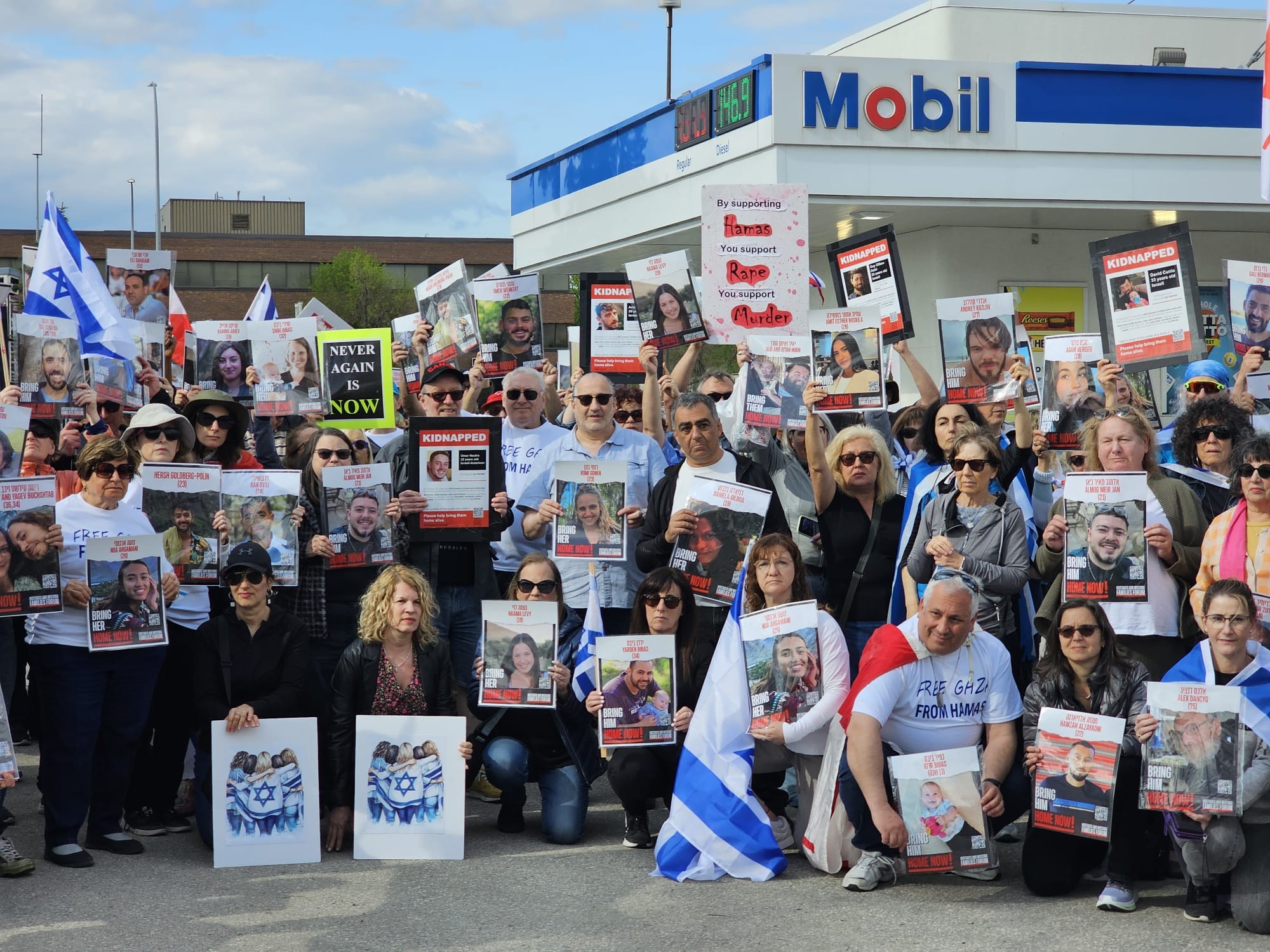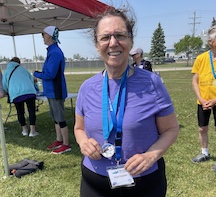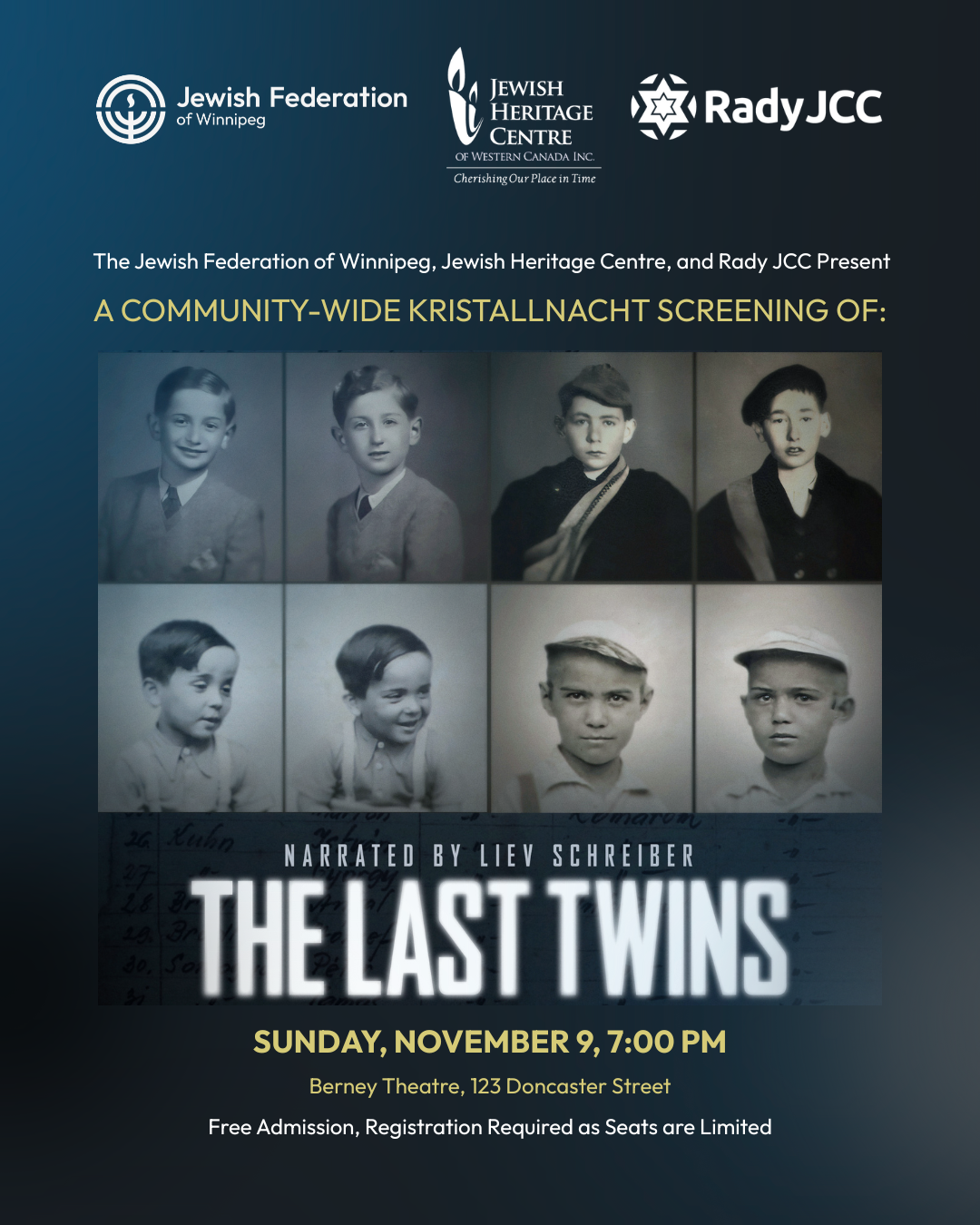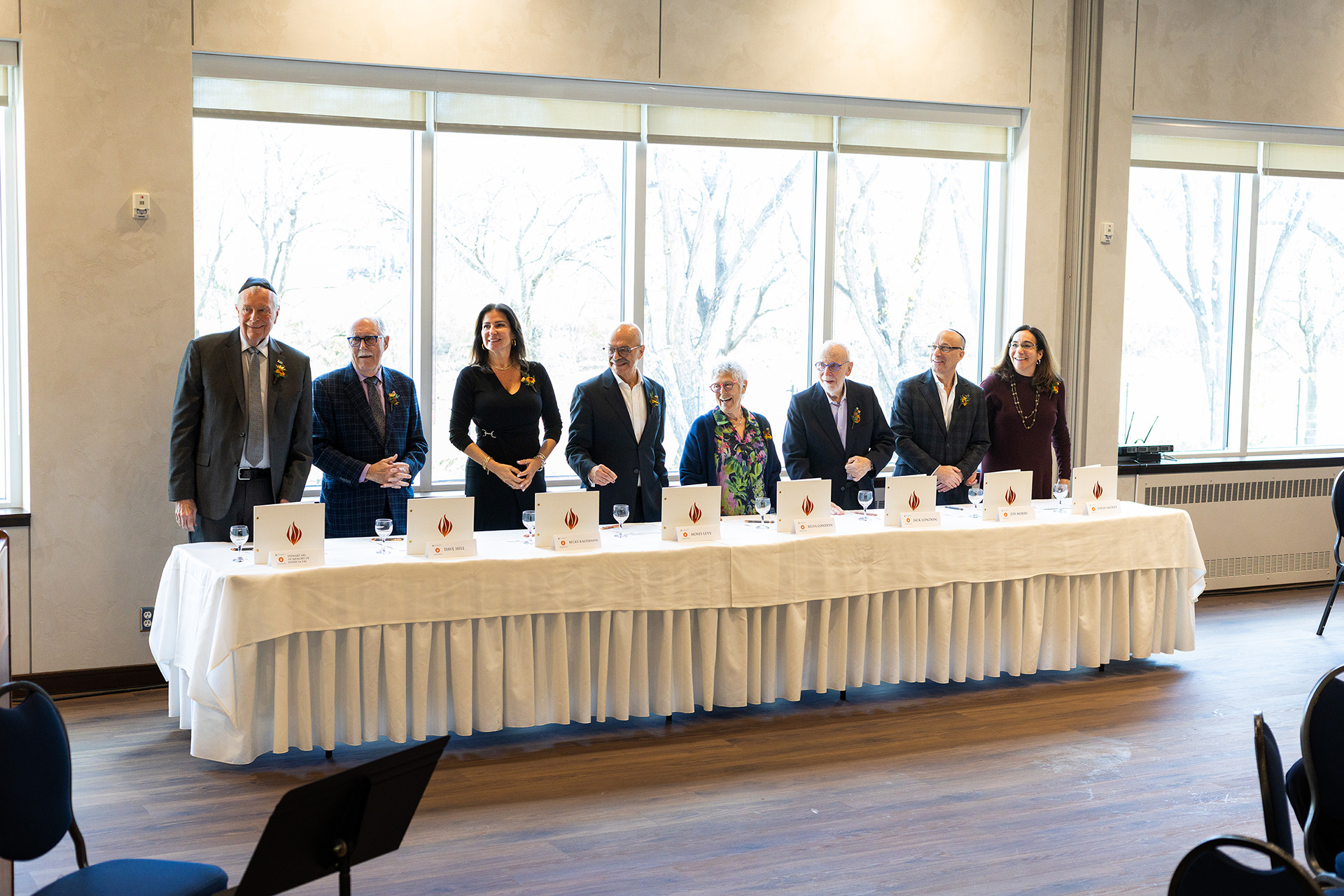Local News
Winnipeggers holding weekly rallies for Israeli hostages in Gaza

By MYRON LOVE For 28 straight weeks now – right through the coldest days of the winter and a recent Sunday with thick smoke in the air – a mixed group of Jewish and non-Jewish Winnipeggers have been gathering on the south-east corner of Grant at Kenaston to show their support for the remaining 128 Israeli hostages that are believed to be still in Gaza.
This writer dropped in at the rally on Victoria Day Monday at 5:00. About 200 participants, holding or draped in Israeli and Canadian flags, each with a poster with the face and name of one of the hostages, lined the sidewalk facing Kenaston while cars whizzed by – with many showing their support by honking.
“We have a real cross section of the community here,” said Danita Aziza, one of the rally co-ordinators. “Our participants range from grade school to seniors. Today, we also had a Pakistani and an Iranian family and we generally have supporters from (the Christian Zionist organization) Bridges for Peace. We are averaging about 200 participants each week – although on May 8, the eve of Yom Hashoah, we had 350 turn out.”
Einat Paz, another organizer, adds that all the synagogues are represented.
Paz was born and grew up in Jerusalem. She earned her Master in Social Work degree at Haifa University. She has been living in Winnipeg for the past 17 years and works for Jewish Child and Family Service. Paz had attended the pro-Israel rally on Parliament Hill in Ottawa in November with longtime friends Danita and Michel Aziza. and the three began working together with Judi Shuster who, with her daughter Baillie (who is currently living and studying in Israel), were among the first members of the community to start putting up posters of the hostages on telephone poles.
“We all felt we needed to do more to bring awareness to the hostages,” Paz notes.
“We started with 36 people,” recalls Danita Aziza, who lived in Israel with her family for five years. “Michel (Aziza) designed our large poster. At our rallies, we hand out posters from the ‘Hostages Families Forum Headquarters’.”
For the first three months, the weekly half-hour vigil was held at the Kenaston location on Friday mornings at 8:00 a. to allow people to get to work by 9:00, Aziza says. “We changed the time to Sundays at 5:00 pm because we felt it would be easier for our supporters to attend.”
The rallies are silent, Aziza points out. “We do not respond to the occasional insults or people swearing at us,” she adds.
“We only allow Canadian and Israeli flags and we hand out the posters at the beginning of each rally and take them back after.”
After each rally, Paz reads out loud a message or invites a rabbi to lead a prayer or a speaker to bring a message pointing out the similarity between the Holocaust and October 7th.
After the rally on May 21, Einat Paz read out loud a letter – in both the original Hebrew and in English, that was received from Merav Berger, whose daughter, Agam, 19, was one of six female soldiers kidnapped from her Army – Nahal Oz base.
Wrote Merav, “Wow…. It’s unimaginable – so long, so many hostages (128 are still in Gaza), this whole reality is unbelievable. I’m very involved in the field of spirituality, and I’m working with the Hostages and Missing Families Forum to promote unity in the country. I believe that our unity, the love we have for one another, and the understanding we all have that there is one common goal will give us the strength to reach our destination. Bring all hostages back home. I have faith in the cooperation and collaboration of every Israeli citizen. This is truly the time for all of us to be involved, to collaborate with one another, and to perform good deeds. May we be blessed with good news very soon! Thank you, Winnipeg for everything you do to bring awareness to the 128 hostages”
“We have heard from other Israelis over the past few months who have heard what we are doing and expressed their gratitude,” Paz says..
After each rally, all participants gather in a group, sing O Canada and Hatikvah and pose for a group photo.
The rallies are advertised through a closed WhatsApp group, and only Einat Paz sends updates about the rallies and photos after each gathering.
“We are working collaboratively with MIC – Manitoba Israeli Coalition, Federation, Synagogues, NCJWC, JNF, and Gray Academy,” she says. “This is a community effort. When we are united we are stronger together.”
“We welcome everyone who wants to show their support for the hostages,” she says. “We would like soon to have 500 of us standing on Kenaston.”
Readers seeking more information about the rallies can go to bringthemhome18@gmail.com.
Local News
Hershfield sisters star in annual 55+ Manitoba Seniors Games

By MYRON LOVE Mindy (Hershfield) Zabenskie has once again proven the old adage that it’s never too late to try something new.
Last August, the retired office worker, along with her younger sister, Esther Hershfield, entered the 55+ Manitoba Seniors Games, which were held in Steinbach. In a field of about 1,200 senior athletes, Zabenskie, competing in the 100m and 200m races, came away with one gold and two silver medals for her performances in the 65+ category. Hershfield did even better with gold medals in the 200m and 100m runs and silver in the 400m and 800m competitions.
In the swimming portion, Esther Hershfield came in first place in her age category in all her swimming events – including the 50m breaststroke, the 100m freestyle and the 100m breaststroke.
As far as the track races went, Hershfield conceded that she “did find the 800m run a little more challenging. I’m more used to the shorter distances, ” she noted. “I will have to do more training for the 800m run. I found that distance a little tiring.”
“It was a lot of fun,” Zabenskie said of this past summer’s competitions – the second go round for the two sisters. Up to that point, they had only run half marathons.
Hershfield noted that last year’s games were held in Brandon –where the sisters were joined by oldest sister Lois, who participated in the cribbage tournament – which is also part of the activities.
Hershfield pointed out that she has always been involved in athletics. She was a phys-ed teacher in Seven Oaks School Division prior to retirement in 2013. She reported that she swims twice a week and runs twice a week with a friend.
Zabenskie, by contrast, is a late bloomer. She only ran her first marathon in 2013 – in Ottawa, while visiting her daughter, Susan. That was three years before she retired.
Looking back, Zabenskie said, she can’t tell you what motivated her to take up running. “I was never athletic,” she noted. “I was never interested in exercise or physical activity. My daughters (Susan and Pamela – who lives in Winnipeg) have always been athletic. They probably encouraged me.”
It was a real challenge for me to start running,” she added. “I am shocked at how well I have done. I really am proud of myself and my accomplishments.”
While Zabenskie did participate in one marathon in Palm Springs several years ago, she generally restricts her running efforts to just two annual runs – the Winnipeg Police Service run in May, and the Winnipeg Fire and Paramedic Service run in October. Those runs are both 5 kilometres.
The Fire and Paramedic Service run, she reported, started and finished at Canadian Mennonite College, while the police event began and ended at Assiniboine Park. Timers clocked in the runners.
“While everyone gets participation medals for doing the marathon,” Zabenskie pointed out, “I have finished in the top ten several times in my age category and have improved my time to less than 40 minutes. I am happy with my results.
Three years ago, to help motivate her and improve her performance, Zabenskie hired a personal trainer. “She has come to know my strengths and weaknesses,” she noted. “She runs with me and is able to point out where I can improve my technique.
“She also got me started on weight training.”
Zabenskie added that she tries to run three times a week in her neighbourhood – weather permitting. In the winter months, she works out on her treadmill. She does weight training twice a week.
She said that she is looking forward to entering the Police marathon again in the spring and both sisters are eager to take on the 55+ competitions, which will be held in Winkler-Morden next summer.
Local News
Kristallnacht Documentary focuses on courageous Hungarian Jew who saved the lives of the last group of twins in Auschwitz

By MYRON LOVE On November 9 and 10, our Jewish community commemorated the 87th anniversary of Kristallnacht – the Night of Broken Glass – the infamous series of pogroms against the Jewish communities of Germany and Austria – with the showing of a new documentary, titled “The Last Twins.” The documentary, written by Patrick McMahon and narrated by actor Liev Schreiber, tells the story of Erno (Tzi) Speigel, who risked his life to save the last surviving twins in Auschwitz.
In her opening remarks, Belle Jarniewski, the executive director of the Jewish Heritage Centre of Western Canada (which co-sponsored the evening, along with the Rady JCC and the Jewish Federation of Winnipeg), reported that over a two-day period in 1938, the Nazi-inspired hordes burned more than 1,400 synagogues in the two countries, desecrated Jewish religious objects, vandalized and ransacked thousands of Jewish-owned businesses, homes and apartments, and stole valuable belongings. Nor were Jewish orphanages, seniors homes and hospitals spared the mayhem. Nearly 100 Jews were murdered and about 30,000 Jewish men were subsequently interned in concentration camps.
To add insult to injury, the Nazis then demanded 1-billion reichsmarks from German and Austrian Jewish communities – “atonement payment” – to clean up the mess.
“It was a turning point,” Jarniewski noted. “It was the moment when words of hatred turned into co-ordinated destruction and when indifference from the rest of the world gave way to the Shoah – the murder of over 6 million European Jews at the hands of the Nazis and their willing collaborators.
The great 16th century kabbalist, Rabbi Isaac Luria, taught that when God created the world, he had to hide his overpowering light in a series of shells. At some point, the shells broke and the divine light fell into the darkest levels of hell. It is the responsibility of Jewish souls to descend into that world to redeem the divine sparks in order to repair the world – the original meaning of tikkun olam.
The Shoah certainly represents the lowest level of darkness. The catastrophe also produced many examples of individuals – both Jewish and non-Jewish – who were willing to risk their lives – in the midst of the darkness and danger around them – to save lives. The names of many of them have been enshrined over the years at Yad Vashem, Israel’s national Holocaust museum. Erno Spiegel was one of them.
It was in May 1944, when Spiegel and his twin sister were deported to Auschwitz. They were among the thousands of Hungarian Jews who were shipped to the death camp, where the notorious Dr. Joseph Mengele greeted each trainload of Jews and determined which were to be sent immediately to the gas chambers and which were to be allowed to live on a little longer as slave labour in the death camp’s factories.
Spiegel and his sister were spared immediate death because the demonic doctor had a special interest in twins, on whom he did numerous gruesome experiments. Many – perhaps most – died.
When a new group of Jewish twins – all of whom were children – were separated from subsequent trainloads of Hungarian Jews they were housed in separate barracks for boys and girls. Mengele serendipitously put the 29-year-old Spiegel in charge of the boys’ care, and Spiegel determined to do his best to look after them.
According to the documentary, not all of the “twins” were really twins. Some were siblings who were born close together and bore a strong resemblance to each other. Spiegel made sure to enter in the forms the same birthday for both brothers in these cases.
He also quickly let them know what had happened to their families and, between experiments, tried to teach them some math and geography.
The documentary includes interviews with several of these twins – survivors – who had immigrated to Israel or North America (or, in one case, stayed in Hungary) who recalled their experiences in Auschwitz and beyond. They reported that, to them, Spiegel became a father figure who saved their lives.
The closest they came to death came in October,1944, when a junior officer discovered them in their barracks and ordered them immediately to the gas chambers. The survivors recalled how Spiegel saved their lives by risking his own to seek out Mengele. The doctor was outraged that a junior officer would try to countermand him and the boys were returned to the barracks.
Spiegel’s efforts to save as many twins as possible were put to the maximum test in January 1945 – when the Russians liberated Auschwitz and the German guards fled. Just prior to the Russians entering the camp, the Nazis had removed most of the prisoners from Auschwitz – including the older sets of twins – and force-marched them in the worst winter weather in years into Germany – leaving the younger twins to fare for themselves. Very few survived these death marches.
The Russians didn’t stay long. So, Spiegel took charge. He promised the kids that he would get them home again. They all set off on foot. They walked for two days – sleeping one night in an abandoned school and the second night in a farmer’s barn. He got them rides with Russian soldiers to Krakow in Poland, where they were housed in a building that had been German headquarters in Krakow. There he found them enough to eat and got identity papers for the kids. He also acquired a pass from the Russians that guaranteed Russian help along the way.
After dropping all the kids in their home communities, they all went their separate ways. Spiegel married and moved to Israel. He and his wife had two kids (who were also interviewed for the documentary). He became involved in theatre in Tel Aviv.
He never talked about Auschwitz.
The first his daughter, Judith Richter, and son, Israel, knew about his heroism, came in 1981 when Richter’s husband, Kobi, came across a story in Life Magazine at a store in Boston where the couple were living. Flipping through the pages, he stumbled on a story about Mengele. In the story was a picture of Spiegel next to a photo of two of the twins.
One of the twin survivors, also living in the States, also saw the story. He contacted Kobi and Judith (who co-hosted the documentary) which led to a dramatic reunion between Spiegel and the twin.
In 1985, Israel put Mengele on trial in absentia. Speigel was called to testify. To his surprise, all those in the courtroom whose lives he saved were asked to stand and about a dozen did.
Several reunions between Spiegel and one or more of the twins followed and the twins continued to reach out to each other after he died in 1993. Toward the end of the documentary, four of the twins are seen holding a reunion in Israel, reminiscing, and celebrating their bar mitzvahs at the Western Wall.
“The last Twins,” Belle Jarniewski observed, “is not only a Holocaust film, but also an urgent reminder of the human capacity to choose compassion over cruelty, to protect the vulnerable, and to recognize the power one person can have in the face of systemic evil.
“But tonight’s commemoration is not only about the past. It is also about the present and the future. At a time when antisemitism has risen exponentially around the world, we are ever more aware of the danger of leaving hate unchallenged. As our youngest Holocaust survivors reach their tenth decade of life, we must continue to connect to education, remembrance and moral courage.”
Local News
Dave Hill’s participation shows that you don’t have to be Jewish to participate in the Jewish Foundation of Manitoba’s Endowment Book of Life

By MYRON LOVE Despite the impression given by certain biased media, Canadian Jewry has many friends from outside our community. On the one hand, there are the Christian Zionist friends of Israel and the Jewish people – groups such as Bridges for Peace and Christian Friends of Israel (see accompanying article), and individuals such as John and Irene Plantz and Rudy and Gina Fidel, who contribute their moral and financial support to Israel and our local Jewish community. There is also Kevin Klein, publisher and editor of the Winnipeg Sun, whose newspaper is a whole-hearted supporter of Israel and the Jewish People and strong fighter against antisemitism.
Then there is Dave Hill, a prominent local lawyer – a partner in the law firm Hill Sokalski – who has been in practice for more than 50 years. On Sunday, November 2, Hill was one of eight new signatories to enter their names and life stories into the Jewish Foundation of Manitoba’s Endowment Book of Life.
Hill reports that he has been making donations to the Foundation for the past ten years. “I believe in giving back to the community,” he says, noting that he is also a supporter of the Winnipeg Foundation and several medical institutions. “I have always had a great deal of compassion for the Jewish People who have suffered over 2000 years of persecution.”
The 2025 signers – in addition to Hill – were Jack and Belva London, Jeff and Sarah Morry, Moe Levy, Becky Kaufmann (a former JFM board member who flew in from Toronto), and Stewart Fay – in memory of his late wife, Patricia.
As explained on the Foundation website, the Endowment Book of Life program – which was started in 1998 – “is a planned program that offers participants an opportunity to leave both a financial and historical legacy to the community.”
Donors promise to leave a bequest to the Foundation, in return for which their family story is inscribed in the Book of Life.
The annual official unveiling of new stories this year was held on Sunday, November 2, at the Shaarey Zedek Synagogue and included brunch, some musical entertainment featuring a talented quartet of singers: Julia Kroft, Alyssa Crockett, Tyler Leighton and Nathanial Muir.
Speaking on behalf of his fellow signers, Jack London noted that, “In Jewish thought, giving tzedakah is not just charity – it’s a moral obligation. An endowment gift is a powerful expression of this duty. It reflects the Jewish principle of tikkun olam. It can be a spiritual act, fulfilling commandments, and enhancing the donor’s connections to their faith.”
The former dean of the University of Manitoba Faculty of Law had words of praise for “the wonderful purpose and mechanisms of the Jewish Foundation and its truly extraordinary staff.”
He noted that the Foundation was established in 1964 by “a group of visionary leaders and has been a beacon of hope and opportunity for decades.” He further pointed out that “its endowment funds have empowered countless initiatives, from supporting education and cultural programs to ensuring the wellbeing of our most vulnerable. Through the Foundation, we see the power of collective generosity, and we remember that when we come together, we can achieve extraordinary things.”
“Giving isn’t just about money,” London observed. It’s also about its impact. Every contribution, no matter how small, has the potential to change and better lives. Every gift by way of endowment results in an endless rate of return from investment which can be employed year after year to support our institutions and assist individuals in need to survive more comfortably and our community to flourish.
“Think of it like planting seeds. You may not see the tree grow overnight, but one day someone will sit in its shade benefitting from the kindness you showed today. In fact, l’dor v’dor, (from generation to generation) is another core Jewish concept. Endowments embody it by supporting those future generations. It is a way for donors to leave not only the currency, but the legacy of Tzedakah (charitable giving), a mitzvah deeply rooted in Jewish ethics.
“So, let’s put some leaves on the ‘tree” of giving’.
“Today’s signers,” London concluded,”have added our familial names, our memories and our promises in support of the Foundation’s good deeds. May good triumph and may peace prevail.”
In his own remarks, John Diamond, the Jewish Foundation of Manitoba’s CEO, described the Endowment Book of Life program as one of the Foundation’s “most meaningful and most successful initiatives”.
“By entering their and their families’ life stories in our book,” he said, “our donors both honour those who came before and inspire those who will come after us.”
In his closing remarks, the JFM’s chair Dan Blankstein reported that the Endowment Book of Life book currently contains over 800 stories. Echoing John Diamond, Blankstein observed that “Our Endowment Book of Life is both a living history of Jewish life in Manitoba and a guide to the future”.


